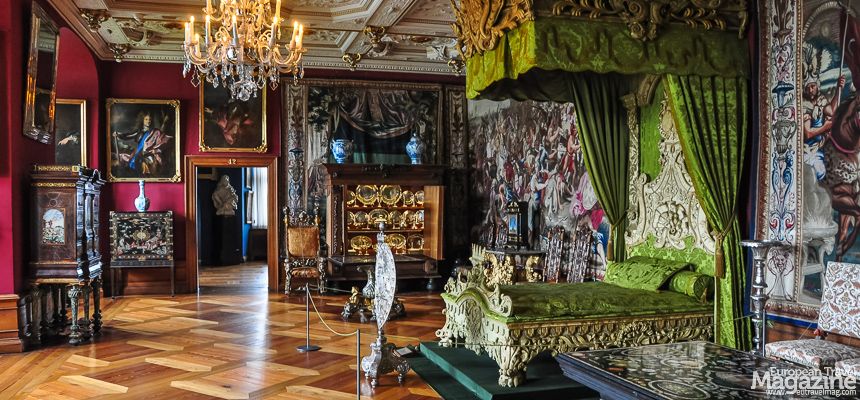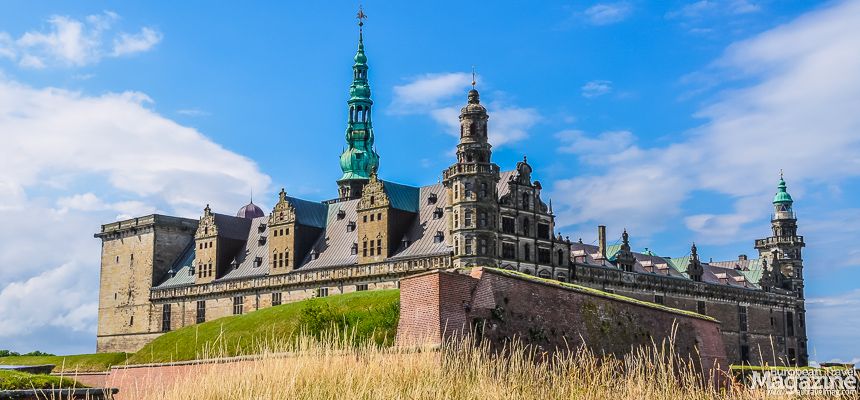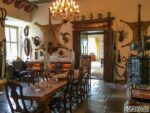Denmark has a surprising amount of castles, manors and palaces. No less than 160 adorn the Danish landscape, from the rich soils of Funen to the aristocratic environment of Zealand. The castles served a number of different purposes. Some were primarily for defensive use, some were residences for kings and queens – and some of them still are!
Discover with us a personal Top10 of our favourite castles in Denmark:
Frederiksborg Castle

Denmark’s Museum of National History resides in this beautiful Renaissance castle in the North of Zealand and portrays 500 years of Danish history in perfect, historic settings.
The castle as we know it today, replaced an older castle acquired by Frederick II and was built on the behest of Renaissance king Christian IV, in the first decade of 1600 as a sign of his power, wealth and sophistication. Christian IV was the longest reigning king in Danish history and one of the most productive – building wise. He is the man behind “Rundetårn”, “Rosenborg Slot”, “Børsen” and many other architectural masterpieces in and around Copenhagen.
A dramatic fire in 1859 destroyed large parts of the interior. The Herculean rebuild of the castle was funded by national donations, lotteries and a generous donation from the founder of the Carlsberg Brewery, J.C. Jacobsen. Today, the castle functions as Denmark’s National History Museum and is yet again one of Europe’s most beautiful Renaissance castles – both inside with 500 years of historical paintings, art, furniture and stunning rooms and outside with its symmetry and wonderful gardens.
Fredensborg Palace

This Baroque palace is one of the Danish Queen’s favourite, and the Royal Family spend much time here in spring and autumn. Built for King Frederick IV, this elegant, white building dates back to 1720. The peace treaty, that ended the Great Nordic War, was signed on the site of the unfinished castle, and it was thus adequately named Fredensborg – “Castle of Peace”.
In the summertime – when not used by the Queen – you can take a guided tour of the lavish rooms, the greenhouse and castle church. The peaceful palace gardens (with free admission) are one of the largest historic gardens in Denmark and one of our finest examples of a baroque garden. You can walk or jog for hours on the estate and surrounding wood that dips it roots in Esrum lake.
Kronborg Castle

Kronborg castle in Helsingør is a World Heritage Site, which is immortalised in Shakespeare’s Hamlet.
Like so many other castles it had a troubled childhood before it looks as it does today. Before Kronborg became a castle, it was first erected in 1426 as a fortress called “Krogen”. Together with Helsingborg Castle on the other side of Øresund (which then was also Danish) it controlled the Baltic Sea and filled the pockets of the Danish kings, which could demand toll from the passing ships.
King Frederik II ordered a rebuild of the medieval fortress from 1574 to 1585, making it this magnificent Renaissance castle and renamed it Kronborg Castle. Unfortunately, it was ravaged by a devastating fire in 1629 which only left the chapel intact. Christian IV had the castle reconstructed with extensive new Baroque decorations, turning it into the Kronborg that impresses so much, even today.
Rosenborg Castle

This fairy tale-like castle was a personal favourite of King Christian IV that had the castle built as a country summerhouse in 1606. Back then, it was outside the protective walls of the city, now it beautifiess the centre of Copenhagen. The castle started modestly as a small hermitage, but within 28 years it underwent four construction phases and was completed in 1633 as the castle we know today. It was built in the Dutch Renaissance style, which was vogue of the time, according to the plans of the same architects that were responsible for Frederiksborg and Kronborg Castle.
The castle is situated in Kongens Have, also known as “Rosenborg Castle Garden”, which is Denmark’s oldest royal garden and free to enter. The castle is open to the public for tours and houses a museum exhibiting the Royal Collections.
Christiansborg Palace

Christiansborg Palace is located on Slotsholmen in Copenhagen, which has an 800 year-long history as Denmark’s centre of power. The present palace was only completed in 1928, but Kings and Queens have ruled from this place for centuries. Today, the palace is the seat of the Danish Parliament, the Danish Prime Minister’s Office and the Supreme Court of Denmark.
Christiansborg is thus home to the three supreme powers: the executive, the legislative, and the judicial power. It is the only building in the world that houses all three of a country’s branches of government. It is also used by the Queen for official events such as gala banquets and public audiences.
The present building – the 3rd with this name – is the last in a series of castles and palaces constructed on the same site since the construction of the first castle in 1167. The palace of today also bears witness to three eras of Danish architecture: The Riding Ground Complex were built from 1738–46, in a Baroque style. The Palace Chapel dates back to 1826 and is in a Neoclassical style. The main part of the current palace, finished in 1928, is in historicist Neo-baroque style.
It’s possible to visit many parts of the palace with a ticket, but you can actually visit the tower for free.
Vallø Castle

It’s difficult to choose a favourite among the many gorgeous, small palaces in Zealand. This one, though, has a very feminine history – and present.
Mette Rosenkrantz, one of Denmark’s richest women in the 2nd half of the 1500s, is attributed with the construction of the main part of the castle. In 1708 Vallø was acquired by King Frederick IV who gave it to his mistress, Anne Sophie Reventlow, who eventually became Queen. King Christian VI passed the property on in 1731 to Queen Sophia Magdalene who in 1737 founded the Noble Vallø Foundation for Unmarried Daughters, giving a home to unmarried women of aristocratic decent.
Now, more than 280 years later, Vallø Castle is still home for unmarried women of aristocratic decent.
The red brick Renaissance castle impresses with its robuts towers, one round and one square, as it’s reflected in the surrounding moat. It’s not possible to visit the castle itself, but the castle grounds are free to roam and give you wonderful views to the charming castle.
Egeskov Castle

We continue our castle quest to Funen, which has the largest concentration of castle and manors in Denmark in proportion to its size. Three times as many as on Zealand. Perhaps it is then unfair that we include only one on our list, but this fairy-tale castle really steals the spotlight,
The late gothic castle structure was erected by Frands Brockenhuus in 1554. Due to the troubles caused by the civil war known as the Count’s Feud, most Danish noblemen built their homes as fortifications around that time. According to legend, it took an entire forest of oak trees to build the foundation, hence the name Egeskov (oak forest).
Egeskov Castle is one of Europe’s best preserved water castles and is idyllically located in a park that has won several garden prices. Although Count Ahlefeldt and his family live in the castle on a daily basis, you have the opportunity to come inside and see the many beautiful halls. There’s an aircraft and automobile museum, a fashion collection, a grand maze, tree top walking bridges and the world’s largest dollhouse. Egeskov Castle has become an attraction for whole family.
Marselisborg Palace

We’re back on solid ground on the peninsula of Jutland and are again drawn towards the more royal castles on this side of the belt. Marselisborg Palace is the Summer and Christmas residence of the Danish Royal family. When the Royal family is in residence, the Changing of the Guard by the Royal Life Guard takes place at noon every day. And when not in residence, the palace grounds, including the Queen’s rose garden, are open to the public.
The youngest of the royal palaces, Marselisborg was built in 1899-1902. It is a Classicist building with a little addition of Baroque that gives the castle its very own character. The palace was given by the people of Denmark as a wedding gift to the Crown Prince Christian (later Christian X) and his consort Princess Alexandrine.
The park was designed in traditional English landscape style, featuring large sweeping lawns dotted with small ponds, clusters of trees and shrub-covered slopes, a rose garden and a herb garden. It’s such a nice stroll around the park, and you have many views of the palace.
Koldinghus

The further south we travel in Jutland, the nearer to the border we get, the more defensive the castles become. The castle of Koldinghus was founded in the 13th century and was expanded since with many functions ranging from fortress, royal residency, ruin and now at last, museum that showcases Koldinghus’ history as well as many exhibitions.
After the Count’s Feud civil war had ended in 1536, the protestant King Christian III, together with his wife, Queen Dorothea, had the former stronghold converted into a residential castle. King Christian IV turned it into a Renaissance palace in early 1600s, and King Frederik IV remodelled it in a Baroque style in the 1720s. In 1808, during the Napoleonic Wars, a fire broke out in a chimney and let all the Kings’ work in ruin.
For many years, Koldinghus loomed as a ruin on the hilltop in Kolding and was only used as a quarry. National poet Hans Christian Andersen visited the castle ruin in 1830 and advocated for its preservation. Measures were taken, but it wasn’t until the 1970s that Koldinghus was restored under the careful leadership of architects Inger and Johannes Exner. It’s actually this restoration that for me is the most interesting feature of Koldinghus.
The ruin was encased and protected by a new architecture, which frames and emphasises its narrative value. An underlying principle was, that the ruined parts of the structure were to be disturbed as little as possible. And so, it’s easy to tell which are new additions. But they blend in so harmoniously, that the restoration received the EUROPA NOSTRA prize in 1993.
Sønderborg Castle
 This imposing fortress is situated in a centuries-old tension field in Sønderborg, near the German border and facing the Eastern seas. Sønderborg Castle was constructed under Valdemar the Great, beginning around year 1170 to protect against attacks by the Wends to the south-east.
This imposing fortress is situated in a centuries-old tension field in Sønderborg, near the German border and facing the Eastern seas. Sønderborg Castle was constructed under Valdemar the Great, beginning around year 1170 to protect against attacks by the Wends to the south-east.
In 1549 King Christian III commissioned architect Hercules von Oberberg to transform the fortress into a Renaissance Castle including a castle church after Martin Luther’s edict for Protestant royal chapels. To this day, the castle church remains the most intact of its kind in Europe from the Reformation period.
After a turbulent period, where the castle was succesively in the hands of the King, local Dukes and Germany, it was purchased by the Danish State in 1921 to house Sønderborg Museum, that to this day showcases the castle’s story as well as the history of the region.
More info
- VisitDenmark official Tourism website
- A complete list of Danish Castles on VisitDenmark’s website
- Danish castles on Wikipedia
- Danish history on Wikipedia
Learn more















































